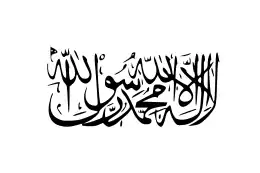Islamic Emirate of Afghanistan
The Islamic Emirate of Afghanistan[11] (Pashto: د افغانستان اسلامي امارات, Da Afġānistān Islāmī Amārāt) was a totalitarian[12][13] Islamic state established in September 1996, when the Taliban began their governance of Afghanistan after the fall of Kabul. At its peak, the Taliban regime controlled approximately 90% of the country, whereas remaining regions in the northeast were held by the Northern Alliance, which maintained broad international recognition as a continuation of the Islamic State of Afghanistan.[14] After the September 11 attacks and subsequent declaration of a "War on Terror" by the United States, international opposition to the regime drastically increased, with diplomatic recognition from the United Arab Emirates and Pakistan being rescinded. The Islamic Emirate ceased to exist on 17 December 2001 after being overthrown by the Northern Alliance, which had been bolstered by the ISAF coalition established after a U.S.-led invasion of the country two months prior.
Islamic Emirate of Afghanistan د افغانستان اسلامي امارات Da Afġānistān Islāmī Amārāt | |||||||||
|---|---|---|---|---|---|---|---|---|---|
| 1996–2001 | |||||||||
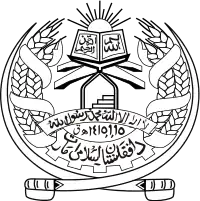 Coat of arms
| |||||||||
Motto: lā ʾilāha ʾillà l-Lāh, Muḥammadun rasūlu l-Lāh لا إله إلا الله محمد رسول الله (Arabic) "There is no god but God. Muhammad is the messenger of God." | |||||||||
Anthem: None (music was outlawed)[1] | |||||||||
.svg.png.webp) | |||||||||
| Capital | |||||||||
| Common languages |
| ||||||||
| Religion | Sunni Islam | ||||||||
| Demonym(s) | Afghan | ||||||||
| Government | Unitary Islamic theocracy under a totalitarian dictatorship | ||||||||
| Amir al-Mu'minin (Leader of the Faithful)[4][5][6] Head of the Supreme Council[7][8][9] | |||||||||
• 1996–2001 | Mohammed Omar | ||||||||
| Prime Minister | |||||||||
• 1996–2001 | Mohammad Rabbani | ||||||||
• 2001 | Abdul Kabir (acting) | ||||||||
| Legislature | Jirga | ||||||||
| Historical era | Afghan Civil War / War on Terror | ||||||||
| 27 September[10] 1996 | |||||||||
| 17 December 2001 | |||||||||
| Area | |||||||||
| 2000 | 587,578 km2 (226,865 sq mi) | ||||||||
| Population | |||||||||
• 2001 | 26,813,057 | ||||||||
| Currency | Afghani | ||||||||
| Calling code | +93 | ||||||||
| ISO 3166 code | AF | ||||||||
| |||||||||
Part of a series on the |
|---|
| History of Afghanistan |
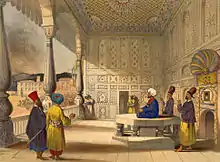 |
| Timeline |
| Related historical names of the region |
|
History
The Taliban and its rule arose from the chaos after the Soviet–Afghan War. It began as an Islamic and Pashtun politico-religious movement composed of madrasa students in southern Afghanistan. Overwhelmingly ethnic Pashtuns, the Taliban blended Pashtunwali tribal code with elements of Salafi Islamic teaching to form an anti-Western and anti-modern Islamic ideology with which it ruled.[15] It began to receive support from neighbouring Pakistan as well as from Saudi Arabia, and the United Arab Emirates (UAE).
Ethnic conflict
The Taliban considered many of Afghanistan's other ethnic communities as foreign. Pashtun people are the largest ethnic group in Afghanistan and comprised the vast majority of the Taliban movement. As the Taliban expanded from their southern and south-eastern strongholds, they encountered more resistance; their brand of Deobandi Islam, incorporated with the Pashtun tribal code of Pashtunwali, was viewed as foreign by the other ethnic groups of Afghanistan.[16][17][18][19] The Battles of Mazar-i-Sharif illustrated this ethnic tension.[20][21]
Governance
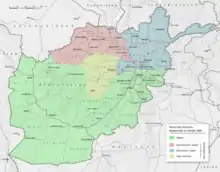
Spreading from Kandahar, the Taliban eventually ruled Kabul in 1996. By the end of 2000, the Taliban were able to rule 90% of the country, aside from the opposition (Northern Alliance) strongholds primarily found in the northeast corner of Badakhshan Province. Areas under the Taliban's direct control were mainly Afghanistan's major cities and highways. Tribal khans and warlords had de facto direct control over various small towns, villages, and rural areas.[22] The Taliban sought to establish law and order and to impose a strict interpretation of Islamic Sharia law, along with the religious edicts of Mullah Omar, upon the entire country of Afghanistan.[1]
During the five-year history of the Islamic Emirate, the Taliban regime interpreted the Sharia in accordance with the Hanafi school of Islamic jurisprudence and the religious edicts of Mullah Omar.[1] The Taliban forbade pork and alcohol, many types of consumer technology such as music,[1] television,[1] filming,[1] and the Internet, as well as most forms of art such as paintings or photography,[1] male and female participation in sport,[1] including football and chess;[1] recreational activities such as kite-flying and keeping pigeons or other pets were also forbidden, and the birds were killed according to the Taliban's ruling.[1] Movie theaters were closed and repurposed as mosques.[1] Celebration of the Western and Iranian New Year was forbidden.[1] Taking photographs and displaying pictures or portraits was forbidden, as it was considered by the Taliban as a form of idolatry.[1] Women were banned from working,[1] girls were forbidden to attend schools or universities,[1] were requested to observe purdah and to be accompanied outside their households by male relatives; those who violated these restrictions were punished.[1] Men were forbidden to shave their beards and required to let them grow and keep them long according to the Taliban's liking, and to wear turbans outside their households.[1][23] Communists were systematically executed. Prayer was made compulsory and those who did not respect the religious obligation after the azaan were arrested.[1] Gambling was banned,[1] and thieves were punished by amputating their hands or feet.[1] In 2000, the Taliban leader Mullah Omar officially banned opium cultivation and drug trafficking in Afghanistan;[1][24][25] the Taliban succeeded in nearly eradicating the majority of the opium production (99%) by 2001.[24][25][26] Under the Taliban governance of Afghanistan, both drug users and dealers were severely prosecuted.[1]
Cabinet ministers and deputies were mullahs with a "madrasah education." Several of them, such as the Minister of Health and Governor of the State bank, were primarily military commanders who were ready to leave their administrative posts to fight when needed. Military reverses that trapped them behind lines or led to their deaths increased the chaos in the national administration.[27] At the national level, "all senior Tajik, Uzbek and Hazara bureaucrats" were replaced "with Pashtuns, whether qualified or not." Consequently, the ministries "by and large ceased to function."[28]
Rashid described the Taliban government as "a secret society run by Kandaharis ... mysterious, secretive, and dictatorial."[29] They did not hold elections, as their spokesman explained:
The Sharia does not allow politics or political parties. That is why we give no salaries to officials or soldiers, just food, clothes, shoes, and weapons. We want to live a life like the Prophet lived 1400 years ago, and jihad is our right. We want to recreate the time of the Prophet, and we are only carrying out what the Afghan people have wanted for the past 14 years.[30]
They modeled their decision-making process on the Pashtun tribal council (jirga), together with what they believed to be the early Islamic model. Discussion was followed by a building of a consensus by the "believers".[31] Before capturing Kabul, there was talk of stepping aside once a government of "good Muslims" took power, and law and order were restored.
As the Taliban's power grew, decisions were made by Mullah Omar without consulting the jirga and without consulting other parts of the country. One such instance is the rejection of Loya Jirga decision about expulsion of Osama Bin Ladin. Mulla Umer visited the capital, Kabul, only twice while in power. Instead of an election, their leader's legitimacy came from an oath of allegiance ("Bay'ah"), in imitation of the Prophet and the first four Caliphs. On 4 April 1996, Mullah Omar had "the Cloak of the Prophet Mohammed" taken from its shrine for the first time in 60 years. Wrapping himself in the relic, he appeared on the roof of a building in the center of Kandahar while hundreds of Pashtun mullahs below shouted "Amir al-Mu'minin!" (Commander of the Faithful), in a pledge of support. Taliban spokesman Mullah Wakil explained:
Decisions are based on the advice of the Amir-ul Momineen. For us consultation is not necessary. We believe that this is in line with the Sharia. We abide by the Amir's view even if he alone takes this view. There will not be a head of state. Instead there will be an Amir al-Mu'minin. Mullah Omar will be the highest authority, and the government will not be able to implement any decision to which he does not agree. General elections are incompatible with Sharia and therefore we reject them.[32]
The Taliban were very reluctant to share power, and since their ranks were overwhelmingly Pashtun they ruled as overlords over the 60% of Afghans from other ethnic groups. In local government, such as Kabul city council[29] or Herat,[33] Taliban loyalists, not locals, dominated, even when the Pashto-speaking Taliban could not communicate with the roughly half of the population who spoke Dari or other non-Pashtun tongues.[33] Critics complained that this "lack of local representation in urban administration made the Taliban appear as an occupying force."[28]
International relations
Regarding its relations with the rest of the world, the Islamic Emirate of Afghanistan held a policy of isolationism: "The Taliban believe in non-interference in the affairs of other countries and similarly desire no outside interference in their country's internal affairs".[1] Only Pakistan, Turkmenistan,[34][35] Saudi Arabia, and the United Arab Emirates (UAE) recognized the legitimacy of the Taliban government.[36] The State was not recognised by the UN, which instead recognized the Islamic State of Afghanistan as being the legitimate government of Afghanistan.
Relations between the Islamic Emirate of Afghanistan and Iran deteriorated in 1998 after Taliban forces seized the Iranian consulate in Mazar-i-Sharif and executed Iranian diplomats. Following this incident, Iran threatened to invade Afghanistan by massing up military forces near the Afghan border but intervention by the United Nations Security Council and the United States prevented the war.
One reason for lack of international recognition was the Taliban's disregard for human rights and the rule of law as demonstrated by their actions on taking power. One of the first acts of the Taliban upon seizing power was the execution of the former Communist President of Afghanistan, Mohammad Najibullah. Before the Taliban had even taken control of Afghanistan's capital they sent out a squad to arrest Najibullah. As Najibullah was staying in the United Nations compound in Kabul, this was a violation of international law. As a further example, the Taliban regime was also heavily criticized for the murder of Iranian diplomats in Afghanistan.[37]
In 1998, the Taliban supported the Islamic militants operating in Chechnya, Xinjiang and Jammu and Kashmir, thus antagonizing Russia, China and India simultaneously. Furthermore, the group has also recognized the Chechen Republic of Ichkeria as a country and established diplomatic relations until its downfall in 2001.
The Taliban also entered in a deal for oil, electricity and gas with Turkmenistan as part of the Turkmenistan-Afghanistan-Pakistan-India pipeline.[35]
Fifteen years later, the Taliban opened an office in Qatar[38] with the goal of beginning talks between themselves, the United States and the Islamic Republic of Afghanistan.[39] There was a conflict after the office raised the white flag of the former Islamic Emirate of Afghanistan, with U.S. Secretary of State John Kerry saying that the office could be closed if there was not a "move forward" in peace negotiations.,[40][41] a peace agreement was however signed on 29 February 2020 which corresponded to 15 Rajab 1441 Hijri and 20 Hoot 1398 on Solar Hijri calendar.[42]
Bamyan Buddhas
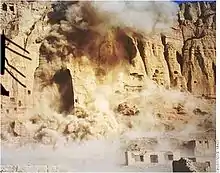
In 1999, Mullah Omar issued a decree protecting the Buddha statues at Bamyan, two 6th-century monumental statues of standing buddhas carved into the side of a cliff in the Bamyan valley in the Hazarajat region of central Afghanistan.
But in March 2001, the statues were destroyed by the Taliban of Mullah Omar following a decree issued by him. The Taliban supreme leader Mullah Omar explained why he ordered the statues to be destroyed in an interview:
I did not want to destroy the Bamiyan Buddha. In fact, some foreigners came to me and said they would like to conduct the repair work of the Bamiyan Buddha that had been slightly damaged due to rains. This shocked me. I thought, these callous people have no regard for thousands of living human beings – the Afghans who are dying of hunger, but they are so concerned about non-living objects like the Buddha. This was extremely deplorable. That is why I ordered its destruction. Had they come for humanitarian work, I would have never ordered the Buddha's destruction.[43]
Then Taliban ambassador-at-large Sayed Rahmatullah Hashemi also said that the destruction of the statues was carried out by the Head Council of Scholars after a Swedish monuments expert proposed to restore the statues' heads. Hashimi is reported as saying: "When the Afghan head council asked them to provide the money to feed the children instead of fixing the statues, they refused and said, 'No, the money is just for the statues, not for the children'. Herein, they made the decision to destroy the statues".[44]
This prompted an international outcry from nations such as Japan, India, Sri Lanka, South Korea, Nepal, Iran, Qatar, and Russia. Even Saudi Arabia and the UAE, both of which were among only three nations to recognize the Islamic Emirate of Afghanistan, voiced their opposition. The Arab branch of UNESCO, a cultural and educational agency of the United Nations, labelled the destruction as "savage".[45][46]
Sanctions
On 15 October 1999, the UN Security Council established a sanctions regime to cover individuals and entities associated with Al-Qaeda, Osama bin Laden and/or the Taliban.[47] Since the U.S. Invasion of Afghanistan in 2001, the sanctions were applied to individuals and organizations in all parts of the world; also targeting former members of the Taliban government.
On 27 January 2010, a United Nations sanctions committee removed five former senior Taliban officials from this list, in a move favoured by Afghan President Karzai. The decision means the five will no longer be subject to an international travel ban, assets freeze and arms embargo. The five men, all high-ranking members of the Taliban government:
- Wakil Ahmad Muttawakil, former foreign minister.
- Fazal Mohammad, former deputy minister of commerce.
- Shams-us-Safa Aminzai, former Taliban foreign affairs press officer.
- Mohammad Musa Hottak, former deputy minister of planning.
- Abdul Hakim, former deputy minister of frontier affairs.
All had been added to the list in January or February 2001.[48][49]
Military under the Taliban
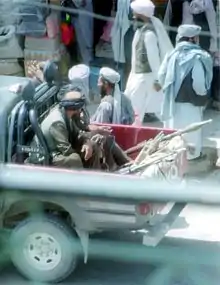
Economy
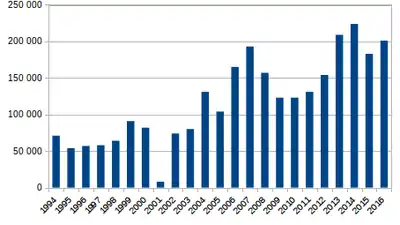
The Kabul money markets responded positively during the first weeks of the Taliban occupation. But the Afghani soon fell in value.[50] They imposed a 50% tax on any company operating in the country, and those who failed to pay were attacked.[51] They also imposed a 6% import tax on anything brought into the country,[52] and by 1998 had control of the major airports and border crossings which allowed them to establish a monopoly on all trade.[53] By 2001 the per capita income of the 25 million population was under $200,[54] and the country was close to total economic collapse.[55] As of 2007 the economy had begun to recover, with estimated foreign reserves of three billion dollars and a 13% increase in economic growth.[56]
Under the Transit treaty between Afghanistan and Pakistan a massive network for smuggling developed. It had an estimated turnover of 2.5 billion dollars with the Taliban receiving between $100 and $130 million per year.[57] These operations along with the trade from the Golden Crescent financed the war in Afghanistan and also had the side effect of destroying start up industries in Pakistan.[58] Ahmed Rashid also explained that the Afghan Transit Trade agreed on by Pakistan was "the largest official source of revenue for the Taliban."[59]
Between 1996 and 1999 Mullah Omar reversed his opinions on the drug trade, apparently as it only harmed kafirs. The Taliban controlled 96% of Afghanistan's poppy fields and made opium its largest source of taxation.[59] Taxes on opium exports became one of the mainstays of Taliban income and their war economy.[59] According to Rashid, "drug money funded the weapons, ammunition and fuel for the war."[59] In The New York Times, the Finance Minister of the United Front, Wahidullah Sabawoon, declared the Taliban had no annual budget but that they "appeared to spend US$300 million a year, nearly all of it on war." He added that the Taliban had come to increasingly rely on three sources of money: "poppy, the Pakistanis and bin Laden."[59]
In an economic sense it seems however he had little choice, as due to the war of attrition continued with the Northern Alliance the income from continued opium production was all that prevented the country from starvation.[60] By 2000 Afghanistan accounted for an estimated 75% of the world's supply and in 2000 grew an estimated 3276 tonnes of opium from poppy cultivation on 82,171 hectares.[61] At this juncture Omar passed a decree banning the cultivation of opium, and production dropped to an estimated 74 metric tonnes from poppy cultivation on 1,685 hectares.[62] Many observers say the ban – which came in a bid for international recognition at the United Nations – was only issued in order to raise opium prices and increase profit from the sale of large existing stockpiles.[59] The year 1999 had yielded a record crop and had been followed by a lower but still large 2000 harvest.[59] The trafficking of accumulated stocks by the Taliban continued in 2000 and 2001.[59] In 2002, the UN mentioned the "existence of significant stocks of opiates accumulated during previous years of bumper harvests."[59] In September 2001 – before 11 September attacks against the United States – the Taliban allegedly authorized Afghan peasants to sow opium again.[59]
There was also an environmental toll to the country, heavy deforestation from the illegal trade in timber with hundreds of acres of pine and cedar forests in Kunar Province and Paktya being cleared.[63][64] Throughout the country millions of acres were denuded to supply timber to the Pakistani markets, with no attempt made at reforestation,[65] which has led to significant environmental damage.[66] By 2001, when the Afghan Interim Administration took power the country's infrastructure was in ruins, Telecommunications had failed, the road network was destroyed and Ministry of Finance buildings were in such a state of disrepair some were on the verge of collapse.[67] On 6 July 1999 president Bill Clinton signed into effect executive order 13129. This order implemented a complete ban on any trade between America and the Taliban regime and on 10 August they froze £5,000,000 in Ariana assets.[68] On 19 December 2000 UN resolution 1333 was passed. It called for all assets to be frozen and for all states to close any offices belonging to the Taliban. This included the offices of Ariana Afghan Airlines.[69] In 1999 the UN had passed resolution 1267 which had banned all international flights by Ariana apart from pre approved humanitarian missions.[70]
See also
References
- Matinuddin, Kamal (1999). "The Taliban's Religious Attitude". The Taliban Phenomenon: Afghanistan 1994–1997. Karachi: Oxford University Press. pp. 34–43. ISBN 0-19-579274-2. Retrieved 8 July 2020.
- "FACTBOX: Five Facts on Taliban Leader Mullah Mohammad Omar". 17 November 2008. Retrieved 29 September 2014.
- "Role of the Taliban's religious police". 27 April 2013. Archived from the original on 9 August 2014. Retrieved 29 September 2014.
- Carlotta Gall (30 July 2015). "Mullah Muhammad Omar, Enigmatic Leader of Afghan Taliban, Is Dead". The New York Times. Retrieved 15 February 2016.
- "Mohammad Omar". Encyclopædia Britannica. Retrieved 15 February 2016.
Emir of Afghanistan
- "Profile: Mullah Mohammed Omar". BBC. 29 July 2015. Retrieved 15 February 2016.
- "Mullah Mohammed Omar". The Independent. 31 July 2015. Retrieved 13 February 2016.
- "Where Will the New Taliban Leader Lead His People?". Moscow Carnegie Center. 11 August 2015. Retrieved 13 February 2016.
- "Mullah Omar: Life chapter of Taliban's supreme leader comes to end". CNN. 29 July 2015. Retrieved 13 February 2016.
- Marcin, Gary (1998). "The Taliban". King's College. Retrieved 26 September 2011.
- Directorate of Intelligence (2001). "CIA – The World Factbook – Afghanistan" (mirror). Retrieved 7 March 2008.
note – the self-proclaimed Taliban government refers to the country as Islamic Emirate of Afghanistan
- Whine, Michael (1 September 2001). "Islamism and Totalitarianism: Similarities and Differences". Totalitarian Movements and Political Religions. 2 (2): 54–72. doi:10.1080/714005450. S2CID 146940668.
- http://turkishpolicy.com/images/stories/media/David_Arnett-6_October_2008.pdf
- "Map of areas controlled in Afghanistan '96".
- Rashid, Taliban (2000)
- "Why are Customary Pashtun Laws and Ethics Causes for Concern?". Archived from the original on 21 October 2014. Retrieved 15 February 2015.
- Administrator. "CF2R". Archived from the original on 10 August 2014. Retrieved 15 February 2015.
- "Wandering Kuchis pay for their Taliban links". The Age. 27 August 2005.
- "lhvnews.com - Diese Website steht zum Verkauf! - Informationen zum Thema lhvnews". lhvnews.com.
- "Massacre in Mazar Sharif – 2 - Hazara.net".
- Genocide, Ethnonationalism, and the United Nations: Exploring the Causes of Mass Killing Since 1945 by Hannibal Travis, pg.115 "The massacres in Mazar-i-Sharif alone in 1998 claimed 8,000–10,000 lives"
- Griffiths 226.
- "US Country Report on Human Rights Practices – Afghanistan 2001". State.gov. 4 March 2002. Retrieved 4 March 2020.
- Farrell, Graham; Thorne, John (March 2005). "Where Have All the Flowers Gone?: Evaluation of the Taliban Crackdown Against Opium Poppy Cultivation in Afghanistan". International Journal of Drug Policy. Elsevier. 16 (2): 81–91. doi:10.1016/j.drugpo.2004.07.007. Retrieved 8 July 2020 – via ResearchGate.
- Ghiabi, Maziyar (2019). "Crisis as an Idiom for Reforms". Drugs Politics: Managing Disorder in the Islamic Republic of Iran. Cambridge: Cambridge University Press. pp. 101–102. ISBN 978-1-108-47545-7. LCCN 2019001098. Retrieved 8 July 2020.
- "Afghanistan, Opium and the Taliban". Retrieved 4 March 2020.
- Rashid 2000, p. 100.
- Rashid 2000, pp. 101–102.
- Rashid 2000, p. 98.
- Rashid 2000, p. 43 Interview with Mullah Wakil, March 1996
- Rashid 2000, p. 95.
- Interview with Taliban spokesman Mullah Wakil in Arabic magazine Al-Majallah, 1996-10-23.
- Rashid 2000, pp. 39–40.
- "Turkmenistan-Foreign Relations". Globalsecurity. Archived from the original on 1 September 2017.
- "Turkmenistan Takes a Chance on the Taliban". Stratfor. Archived from the original on 8 December 2019.
- Guelke, Adrian (25 August 2006). Terrorism and Global Disorder – Adrian Guelke – Google Libros. ISBN 9781850438038. Retrieved 15 August 2012.
- "SECURITY COUNCIL STRONGLY CONDEMNS MURDER OF IRANIAN DIPLOMATS IN AFGHANISTAN - Meetings Coverage and Press Releases". www.un.org. Archived from the original on 4 May 2001.
- Michael Semple. "The Taliban's Qatar office is a positive step, but not a prologue to peace". the Guardian. Retrieved 15 February 2015.
- "U.S. Will Negotiate With Taliban, Helping It Return To Power - Investors.com". Investor's Business Daily. Retrieved 15 February 2015.
- Crilly, Rob (19 June 2013). "Fury from Hamid Karzai plunges US talks with Taliban into disarray" – via www.telegraph.co.uk.
- "Kerry: Taliban's Qatar Office Could be Closed if no 'Move Forward'". VOA. Retrieved 15 February 2015.
- "What does the Taliban-US agreement say?". ALJAZEERA. Archived from the original on 14 April 2020.
- Mohammad Shehzad (3 March 2001). "The Rediff Interview/Mullah Omar". The Rediff. Kabul. Retrieved 27 October 2010.
- Kassaimah, Sahar (12 January 2001). "Afghani Ambassador Speaks At USC". IslamOnline. Archived from the original on 3 April 2008. Retrieved 6 January 2008.
- "Over World Protests, Taliban Are Destroying Ancient Buddhas". 4 March 2001. Retrieved 23 December 2016.
- "Bamiyan statues: World reaction". 5 March 2001. Retrieved 23 December 2016.
- "Bangor Daily News – Google News Archive Search". Retrieved 15 February 2015.
- "U.N. Reconciles itself to Five Members of Mulla Omar's Cabinet". America At War. 27 January 2010. Archived from the original on 20 May 2013. Retrieved 15 February 2015.
- "UN lifts sanctions on 5 former Taliban". CBC News. 27 January 2010. Archived from the original on 8 November 2012. Retrieved 29 December 2017.
- Marsden, Peter (1998). The Taliban: war, religion and the new order in Afghanistan. Zed Books. p. 51. ISBN 978-1-85649-522-6.
- Lansford, Tom (2011). 9/11 and the Wars in Afghanistan and Iraq: A Chronology and Reference Guide. ABC-CLIO. p. 147. ISBN 978-1-59884-419-1.
- Pugh, Michael C.; Neil Cooper Jonathan Goodhand (2004). War Economies in a Regional Context: Challenges of Transformation. Lynne Rienner. p. 48. ISBN 978-1-58826-211-0.
- Pugh, Michael C.; Neil Cooper Jonathan Goodhand (2004). War Economies in a Regional Context: Challenges of Transformation. Lynne Rienner. p. 52. ISBN 978-1-58826-211-0.
- Castillo, Graciana del (2008). Rebuilding War-Torn States: The Challenge of Post-Conflict Economic Reconstruction. Oxford University Press. p. 167. ISBN 978-0-19-923773-9.
- Skaine, Rosemarie (2009). Women of Afghanistan in the Post-Taliban Era: How Lives Have Changed and Where They Stand Today. McFarland. p. 57. ISBN 978-0-7864-3792-4.
- Skaine, Rosemarie (2009). Women of Afghanistan in the Post-Taliban Era: How Lives Have Changed and Where They Stand Today. McFarland. p. 58. ISBN 978-0-7864-3792-4.
- Nojum, Neamatollah (2002). The Rise of the Taliban in Afghanistan: Mass Mobilization, Civil War and the Future of the Region. St Martin's Press. p. 178. ISBN 978-0-312-29584-4.
- Nojum, Neamatollah (2002). The Rise of the Taliban in Afghanistan: Mass Mobilization, Civil War and the Future of the Region. St Martin's Press. p. 186. ISBN 978-0-312-29584-4.
- Chouvy, Pierre-Arnaud (2010). Opium: uncovering the politics of the poppy. Harvard University Press. pp. 52ff.
- Shaffer, Brenda (2006). The limits of culture: Islam and foreign policy. MIT Press. p. 283. ISBN 978-0-262-69321-9.
- Thourni, Francisco E. (2006). Frank Bovenkerk (ed.). The Organized Crime Community: Essays in Honor of Alan A. Block. Springer. p. 130. ISBN 978-0-387-39019-2.
- Lyman, Michael D. (2010). Drugs in Society: Causes, Concepts and Control. Elsevier. p. 309. ISBN 978-1-4377-4450-7.
- Griffin, Michael (2000). Reaping the whirlwind: the Taliban movement in Afghanistan. Pluto Press. p. 147. ISBN 978-0-7453-1274-3.
- Wehr, Kevin (2011). Green Culture: An A-to-Z Guide. Sage. p. 223. ISBN 978-1-4129-9693-8.
- Rashid, Ahmed (2002). Taliban: Islam, oil and the new great game in central Asia. I.B.Tauris. p. 187. ISBN 978-1-86064-830-4.
- Clements, Frank (2003). Conflict in Afghanistan: a historical encyclopedia. ABC-CLIO. p. 148. ISBN 978-1-85109-402-8.
- Bennett, Adam (2005). Reconstructing Afghanistan (illustrated ed.). International Monetary Fund. p. 29. ISBN 978-1-58906-324-2.
- Farah, Douglas; Stephen Braun (2008). Merchant of Death: Money, Guns, Planes, and the Man Who Makes War Possible. Wiley. p. 146. ISBN 978-0-470-26196-5.
- Askari, Hossein (2003). Economic sanctions: examining their philosophy and efficacy. Potomac. p. 56. ISBN 978-1-56720-542-8.
- Pillar, Paul R. (2003). Terrorism and U.S. foreign policy. Brookings Institution. p. 77. ISBN 978-0-8157-7077-0.
External links
- Official website
- (old) Islamic Emirate of Afghanistan website
- Interview with official representatives of Islamic Emirate of Afghanistan
| Preceded by Islamic State of Afghanistan |
Islamic Emirate of Afghanistan 1996 – 2001 |
Succeeded by Afghan Interim Administration |
